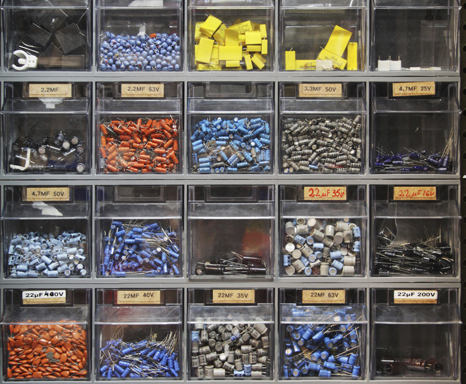
By force of habit we tend to assume computers are made of silicon, but there is actually no necessary connection between the machine and the material. All that an engineer needs to do to make a computer is to find a way to build logic gates — the elementary building blocks of digital computers — in whatever material is handy.
So logic gates could theoretically be made of pipes of water, channels for billiard balls or even mazes for soldier crabs.
By comparison Tae Seok Moon’s ambition, which is to build logic gates out of genes, seems eminently practical. As a postdoctoral fellow in the lab of Christopher Voigt, PhD, a synthetic biologist at the Massachusetts Institute of Technology, he recently made the largest gene (or genetic) circuit yet reported.
Moon, PhD, now an assistant professor of energy, environmental and chemical engineering in the School of Engineering & Applied Science at Washington University in St. Louis is the lead author of an article describing the project in the Oct. 7 issue of Nature. Voigt is the senior author.
The tiny circuits constructed from these gene gates and others like them may one day be components of engineered cells that will monitor and respond to their environments.
The number of tasks they could undertake is limited only by evolution and human ingenuity. Janitor bacteria might clean up pollutants, chemical-engineer bacteria pump out biofuels and miniature infection-control bacteria might bustle about killing pathogens.
How to make an AND gate out of genes
The basis of modern computers is the logic gate, a device that makes simple comparisons between the bits, the 1s and 0s, in which computers encode information. Each logic gate has multiple inputs and one output. The output of the gate depends on the inputs and the operation the gate performs.
An AND gate, for example, turns on only if all of its inputs are on. An OR gate turns on if any of its inputs are on.
Suggestively, genes are turned on or off when a transcription factor binds to a region of DNA adjacent to the gene called a promotor.
To make an AND gate out of genes, however, Moon had to find a gene whose activation is controlled by at least two molecules, not one. So only if both molecule 1 AND molecule 2 are present will the gene be turned on and translated into protein.
Such a genetic circuit had been identified in Salmonella typhimurium, the bacterium that causes food poisoning. In this circuit, the transcription factor can bind to the promotor of a gene only if a molecule called a chaperone is present. This meant the genetic circuit could form the basis of a two-input AND gate.
The circuit Moon eventually built consisted of four sensors for four different molecules that fed into three two-input AND gates. If all four molecules were present, all three AND gates turned on and the last one produced a reporter protein that fluoresced red, so that the operation of the circuit could be easily monitored.
In the future, Moon says, a synthetic bacterium with this circuit might sense four different cancer indicators and, in the presence of all four, release a tumor-killing factor.
Crosstalk and timing faults
There are huge differences, of course, between the floppy molecules that embody biological logic gates and the diodes and transistors that embody electronic ones.
Engineers designing biological circuits worry a great deal about crosstalk, or interference. If a circuit is to work properly, the molecules that make up one gate cannot bind to molecules that are part of another gate.
This is much more of a problem in a biological circuit than in an electronic circuit because the interior of a cell is a kind of soup where molecules mingle freely.
To ensure that there wouldn’t be crosstalk among his AND gates, Moon mined parts for his gates from three different strains of bacteria: Shigella flexneri and Pseudomonas aeruginosa, as well as Salmonella.
Although the parts from the three different strains were already quite dissimilar, he made them even more so by subjecting them to error-prone copying cycles and screening the copies for ones that were even less prone to crosstalk (but still functional).
Another problem Moon faced is that biological circuits, unlike electronic ones, don’t have internal clocks that keep the bits moving through the logic gates in lockstep. If signals progress through layers of gates at different speeds, the output of the entire circuit may be wrong, a problem called a timing fault.
Experiments designed to detect such faults in the synthetic circuit showed that they didn’t occur, probably because the chaperones for one layer of logic gates degrades before the transcription factors for the next layer are generated, and this forces a kind of rhythm on the circuit.
Hijacking a bacterium’s controller
“We’re not trying to build a computer out of biological logic gates,” Moon says. “You can’t build a computer this way. Instead we’re trying to make controllers that will allow us to access all the things biological organisms do in simple, programmable ways.”
“I see the cell as a system that consists of a sensor, a controller (the logic circuit), and an actuator,” he says. “This paper covers work on the controller, but eventually the controller’s output will drive an actuator, something that will do work on the cell’s surroundings. “
An synthetic bacterium designed by a friend of Moon’s at Nanyang Technological University in Singapore senses signaling molecules released by the pathogen Pseudomonas aeruginosa. When the molecules reach a high enough concentration, the bacterium generates a toxin and a protein that causes it to burst, releasing the toxin, and killing nearby P. aeruginosa.
“Silicon cannot do that,” Moon says.